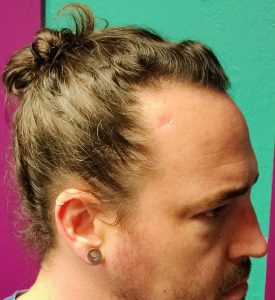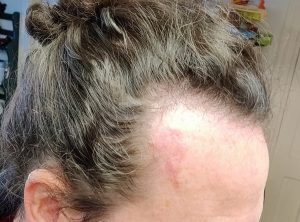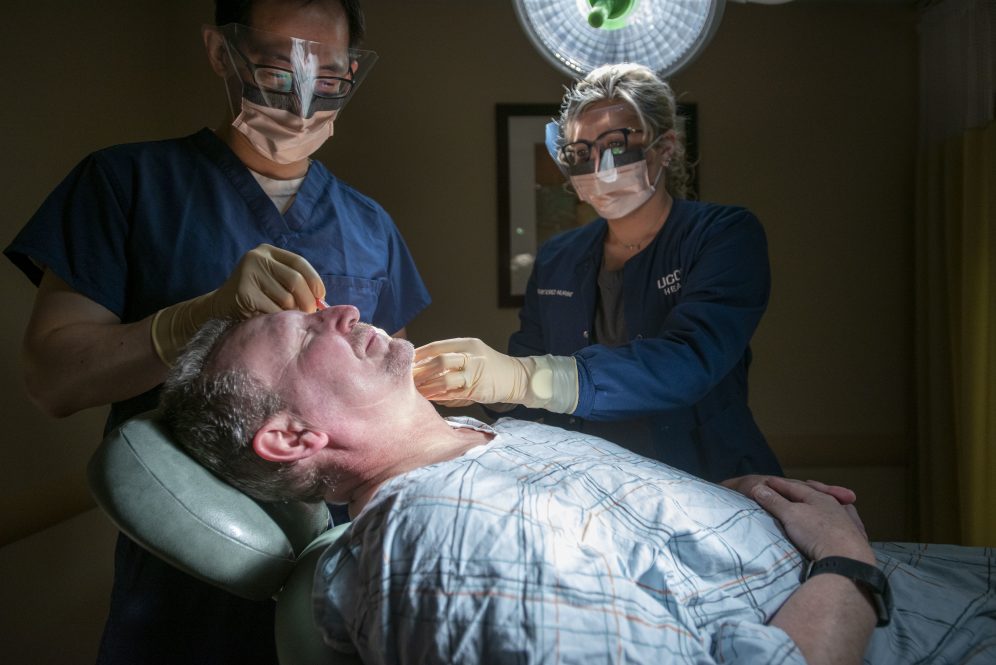The constant spot on Eli Bowman’s forehead looked like he just had a scrape that wouldn’t go away. The area would scar up, scab, and start bleeding.
He knew his grandfather and other family members had skin cancer in their later years, but he was only 38 years old, could it be more than a cut that wouldn’t heal?
He met with Dr. Hao Feng, assistant professor of dermatology and director of laser surgery and cosmetic dermatology at UConn Health Department of Dermatology who ordered an initial biopsy of the area, and confirmed that Bowman had basal cell carcinoma (BCC).
An estimated 3.6 million Americans are diagnosed with BCC each year, the most common type of skin cancer. Other common skin cancers include squamous cell carcinomas and melanomas.
Most people who develop this type of skin cancer have fair skin that they seldom protected with sunscreen or sun-protective clothing. However, anyone can get skin cancer and should protect their skin year-round.
Bowman who is Scottish and fair-skinned admitted that he often waited too long in the sun before putting on sunscreen or protecting his skin from the sun’s harmful rays.
BCCs can look like open sores, red patches, pink growths, shiny bumps, scars, or growths with slightly elevated, rolled edges and/or a central indentation. At times, BCCs may ooze, crust, itch, or bleed. The lesions commonly arise in sun-exposed areas of the body. In patients with darker skin, about half of BCCs are brown.

One common sign is a slowly growing, non-healing spot that sometimes bleeds. When found early, this skin cancer is highly treatable. Given time to grow, this skin cancer can grow deep, injuring nerves, blood vessels, and anything else in its path. As the cancer cells pile up and form a large tumor, the cancer can reach into the bone beneath. This can change the way you look, and for some people, the change may be disfiguring.
Feng, a Mohs surgeon performed Mohs surgery which is considered the most effective technique for treating many BCC on functionally and cosmetically sensitive areas of the body to remove Bowman’s cancer.
This surgical technique allows doctors to remove the tumor while minimizing the loss of healthy surrounding tissue and subsequent deformities.
The procedure is done in stages, all in one visit, while the patient waits between each stage. After removing a layer of tissue, the surgeon examines it under a microscope in an on-site lab. If any cancer cells remain, the surgeon knows the exact area where they are and removes another layer of tissue from that precise location, while sparing as much healthy tissue as possible. The doctor repeats this process until no cancer cells remain. Reconstruction of the surgical defect is also done the same day to close the wound and optimize the cosmetic and functional results.
“The surgery wasn’t as bad as I expected,” says Bowman. “After two weeks the stitches dissolved and it healed well. Dr. Feng was awesome.”

Since his surgery and experience with skin cancer Bowman is now more careful when out in the sun making sure to use sunscreen before going out and covering up with hats.
“It’s important not to wait to get an unusual spot looked at and to get regular skin checkups,” says Bowman. “Skin cancer doesn’t care about age.”
You can take these steps to reduce your skin cancer risk by practicing skin safety.
- Seek shade between 10 a.m. and 4 p.m. when the sun’s UV rays are strongest.
- Wear protective clothing, such as a wide-brimmed hat, sunglasses, and clothes with an ultraviolet protection factor (UPF) as high as 50.
- Wear sunscreen that’s at least SPF 30, broad-spectrum, and water-resistant. Apply liberally every two hours.
- Check your skin regularly and call your dermatologist right away if you have any changes.
If you are high risk, you should have a full-body skin examination at least once a year. If you see a new or changing spot, consult your dermatologist right away. Early detection gives you the best chance for a cure with the most minimal treatment.
Read more about the myths and facts about skin cancer.
The Department of Dermatology at UConn Health offers highly specialized dermatological care for patients of all ages in a welcoming and confidential practice and includes Mohs Surgery and the Cutaneous Oncology Center & Melanoma Program.



